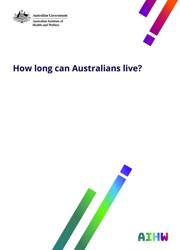Summary
On average, Australians are living longer than ever before. Life expectancy has been steadily increasing, and this is matched by increases in the proportion of deaths that occur at older ages and in the median age at death. However, the oldest age at death (often referred to as maximum age at death) has fluctuated from year to year and shown minimal increases over time. While improvements in life expectancy are resulting in an ageing population and growth in the population of centenarians, few Australians die at ages higher than 110. This suggests that mortality is being compressed into older ages and may be slowly converging towards a maximum age at death rather than a situation where maximum life span is increasing along with average life expectancy. There is ongoing debate on whether there is a biological limit to the human life span. In Australia, the oldest living person is believed to have died at age 114. Globally the oldest person is believed to have lived to 122 years (Jeune et al. 2010).
Why study longevity?
When looking at how long Australians live, the focus tends to be on average life expectancy. However, there are other measures of how long we live, and these add different nuances to our understanding of the health of Australians.
This report seeks to enhance our understanding of how long Australians are currently living and how this has changed over time. It looks at whether, with increasing life expectancy, other measures of longevity are also rising to provide insights into whether we can expect Australians to continue to live to increasingly older ages.
Sustained increases in some measures of longevity
Life expectancy in Australia has increased by 13.7 years for males and 11.2 years for females since the 1960s. People born in 2019–2021 can expect to live to more than 81 years (81.3 years for males and 85.4 for females).
The median age at death (the age by which half of all deaths have occurred) has also increased over time. Between 1964 and 2021, the median age at death increased by 11.5 years for males (from 68.1 to 79.6 years) and 10.9 years for females (from 74.0 to 84.9 years).
The modal age at death offers a further metric of longevity revealing the age at which the highest proportion of deaths occur. During the 1960s to the mid-1970s, deaths during infancy were the most common age at death. A higher concentration of deaths at older ages (74 and over) then became more commonplace. During the decade to 2021, the highest modal age at death was 87 for males and 91 years for females.
More Australians are dying beyond 100 years, but few past 110
The number of centenarian deaths (those aged 100 and over) has been rapidly increasing. In 2021, 1 in 72 deaths in Australia were of people aged 100 or more (2,247 deaths). This is an increase from 1 in 1,214 in 1964 (83 deaths). Over the period 1964–2021, most (94%) of these deaths occurred between the ages of 100 and 104 years. Over the same period, deaths at extreme old ages (110 years and above) remained rare.
Maximum age at death has not increased like other measures of longevity
While we have seen significant gains in life expectancy in Australia over time, this is not matched by changes in the maximum age at death. The average age of the 10 most elderly deaths in the 1960s ranged from 101.6 to 104.4 years for males and 103.5 to 105.8 years for females. In the most recent decade to 2021, the range was 104.7 to 107.3 years for males and 107.8 to 109.9 years for females. The single oldest age at death in Australia shows considerable year to year fluctuation, and is 114 years for females (occurring in 1983, 2002 and 2017) and 111 for males (occurring in 1991, 1997, 2002, 2003, 2020 and 2021).
Why are people living longer on average but there has been minimal improvement in the longest living individuals?
There are many reasons behind increased life expectancy in Australia, largely related to improved medical knowledge and technology, the widespread availability of antibiotics and vaccines, healthcare availability and access, improved living conditions and overall increasing wealth in Australia (AIHW 2022a). Better disease treatment, especially for infectious and parasitic diseases led to reductions in infant mortality. Improvements in sanitation, food quality and health education have contributed to lowering death rates and increasing life expectancy in people of all ages.
Improvements in life expectancy due to the above factors have resulted in an ageing population and a rising centenarian population (people aged 100 years or more). However, few people are living past 110 to become supercentenarians.
What more do we need to learn?
While centenarian deaths are increasing, these events are still relatively rare. The population of centenarians is growing but remains a very small portion of the overall population. Accurate and complete data on this group are vital to understanding mortality and population trajectories. More rigorous validation of deaths at extreme ages in Australia, coupled with linked births and deaths data, and more detailed population statistics, could enhance the precision of information on Australian longevity. This would enable more accurate assessment of the potential impacts of current trends in maximum life span on Australian society.
Summary
- Introduction
- About this report
- Measuring longevity
- Fixed or unlimited life span?
- Longest living humans over the past century
- How has Australia's population aged?
- How has age at death changed over time?
- How long do Australians live?
- International comparisons
- What more do we need to learn?
- Appendix A: Data sources
- Appendix B: Validating age at death
End matter: References; Acknowledgements; Abbreviations; List of tables; List of figures; Related publications



